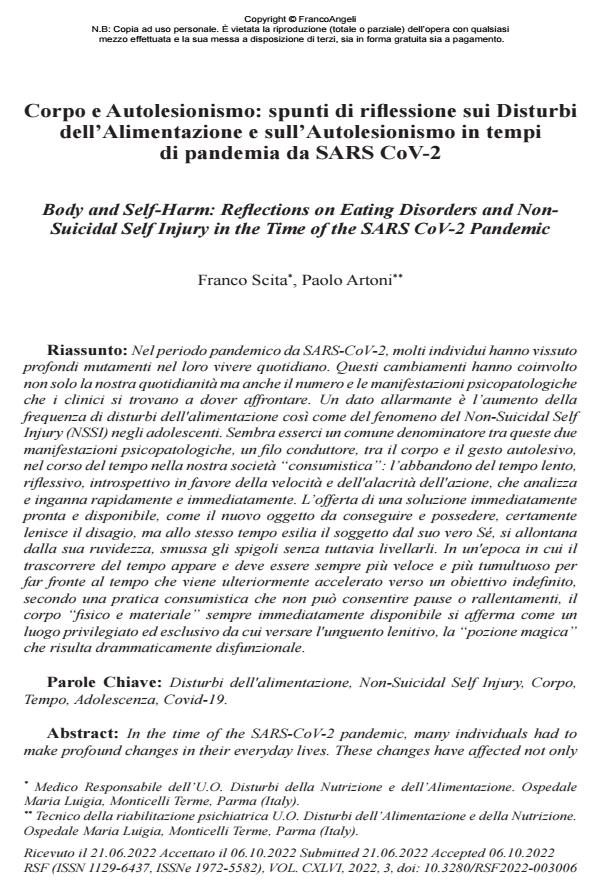Corpo e Autolesionismo: spunti di riflessione sui Disturbi dell’Alimentazione e sull’Autolesionismo in tempi di pandemia da SARS CoV-2
Titolo Rivista RIVISTA SPERIMENTALE DI FRENIATRIA
Autori/Curatori Franco Scita, Paolo Artoni
Anno di pubblicazione 2022 Fascicolo 2022/3
Lingua Italiano Numero pagine 19 P. 105-123 Dimensione file 229 KB
DOI 10.3280/RSF2022-003006
Il DOI è il codice a barre della proprietà intellettuale: per saperne di più
clicca qui
Qui sotto puoi vedere in anteprima la prima pagina di questo articolo.
Se questo articolo ti interessa, lo puoi acquistare (e scaricare in formato pdf) seguendo le facili indicazioni per acquistare il download credit. Acquista Download Credits per scaricare questo Articolo in formato PDF

FrancoAngeli è membro della Publishers International Linking Association, Inc (PILA)associazione indipendente e non profit per facilitare (attraverso i servizi tecnologici implementati da CrossRef.org) l’accesso degli studiosi ai contenuti digitali nelle pubblicazioni professionali e scientifiche
Nel periodo pandemico da SARS-CoV-2, molti individui hanno vissuto profondi mutamenti nel loro vivere quotidiano. Questi cambiamenti hanno coinvolto non solo la nostra quotidianità ma anche il numero e le manifestazioni psicopatologiche che i clinici si trovano a dover affrontare. Un dato allarmante è l’aumento della frequenza di disturbi dell'alimentazione così come del fenomeno del Non-Suicidal Self Injury (NSSI) negli adolescenti. Sembra esserci un comune denominatore tra queste due manifestazioni psicopatologiche, un filo conduttore, tra il corpo e il gesto autolesivo, nel corso del tempo nella nostra società "consumistica": l’abbandono del tempo lento, riflessivo, introspettivo in favore della velocità e dell'alacrità dell'azione, che analizza e inganna rapidamente e immediatamente. L’offerta di una soluzione immediatamente pronta e disponibile, come il nuovo oggetto da conseguire e possedere, certamente lenisce il disagio, ma allo stesso tempo esilia il soggetto dal suo vero Sé, si allontana dalla sua ruvidezza, smussa gli spigoli senza tuttavia livellarli. In un'epoca in cui il trascorrere del tempo appare e deve essere sempre più veloce e più tumultuoso per far fronte al tempo che viene ulteriormente accelerato verso un obiettivo indefinito, secondo una pratica consumistica che non può consentire pause o rallentamenti, il corpo "fisico e materiale" sempre immediatamente disponibile si afferma come un luogo privilegiato ed esclusivo da cui versare l'unguento lenitivo, la "pozione magica" che risulta drammaticamente disfunzionale.
Parole chiave:Disturbi dell'alimentazione, Non-Suicidal Self Injury, Corpo, Tempo, Adolescenza, Covid-19.
Franco Scita, Paolo Artoni, Corpo e Autolesionismo: spunti di riflessione sui Disturbi dell’Alimentazione e sull’Autolesionismo in tempi di pandemia da SARS CoV-2 in "RIVISTA SPERIMENTALE DI FRENIATRIA" 3/2022, pp 105-123, DOI: 10.3280/RSF2022-003006